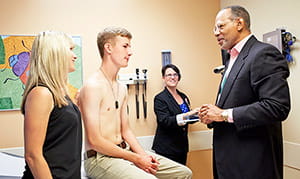New survey tool helps physicians provide better patient/family experience
 Cincinnati Children’s began piloting a new survey tool last July for patients and families who use outpatient services. The NRC Connect Experience Survey polls families about their interactions with physicians in a prompt and more succinct way.
Cincinnati Children’s began piloting a new survey tool last July for patients and families who use outpatient services. The NRC Connect Experience Survey polls families about their interactions with physicians in a prompt and more succinct way.
Previously, surveys were conducted in a 30-minute phone call approximately two-to-four weeks after the clinic visit. NRC Connect is delivered via text or a phone call using interactive voice response within 48 hours of the visit. It consists of fewer than 10 questions and takes about 2 minutes to complete.
The result, says Anne Boat, MD, patient experience officer, is a big increase in survey participation rates. “Because it’s so convenient and administered in a timely way, we are getting a lot more physician-specific data,” she says. “We can then give that feedback to providers more quickly.”
“Our intent was to improve the survey process, learn what we needed to do better and establish a provider model to help our physicians,” says Boat. “There are many external models we could have adapted, but we decided it would be more powerful to study what our own physicians were doing so well and create a Cincinnati Children’s model instead.”
Julie Elkus, director of innovation, Patient Family Experience, and Kurt Myers, community outreach coordinator, interviewed 17 of our highest performing physicians and even shadowed some of them to learn the secrets to their success.
“The doctors we spoke with are all unique, but some of their practices are very consistent,” says Elkus. “For example, they all believe in the value of acknowledging a wait and apologizing, first thing, to let the family know we value their time. It helps to get past the frustration and make the visit more successful.”
Other practices include acknowledging the child early in the visit and getting to know who is in the room; thinking out loud to help families understand the rationale for a diagnosis or treatment recommendation; and staying seated until all the family’s questions are answered.
Once the common themes were identified, the Patient Family Experience team developed them into a provider model and sent it to Talk Board, an online community of 200 parents of patients from around the country, for their feedback and endorsement. Says Elkus, “There were some suggested changes, but the vast majority felt we had identified what was most important to families.”
The final, formalized guidelines became Cincinnati Children’s provider model, called “Engaging Patients and Families.” (See sidebar)
“As a physician, it can be discouraging to get less-than-positive feedback,” says Boat. “We are working hard to communicate in a limited time frame while providing the best possible care for our patients. I am so impressed with our physicians who have been willing to embrace family feedback in order to understand the family’s perspective and to identify where the family might be misunderstanding our words or actions. It gives us the opportunity to clarify what we said or did.”
Says Elkus, “It is inspiring to see how thoughtful and empathic our providers are in caring for patients and families and how eager many of them are to learn how to improve. They want to know the best way to interact so everyone gets the best outcome.”



